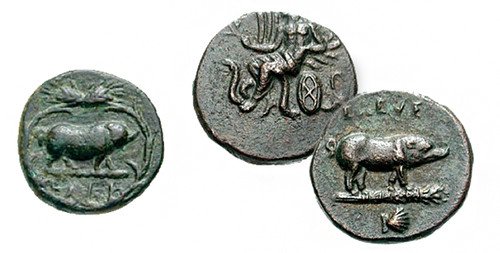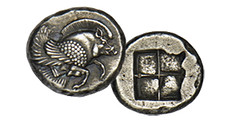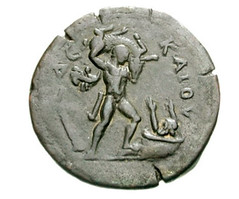
PREV ARTICLE
NEXT ARTICLE
FULL ISSUE
PREV FULL ISSUE
BOARS, HOGS, SOWS AND PIGLETS ON ANCIENT COINSI really enjoy Mike Markowitz' series on ancient coins for CoinWeek.
His November 3, 2014 article covers an unusual topic: Boars, Hogs, Sows and Piglets on Ancient
Coins. Here's an excerpt. -Editor
 The Greeks: When Pigs Flew
And at least six Greek towns used the image of a winged boar on their coins: Klazomenai, Samos, Kyzikos, Ialysos, Kisthene and Mytilene. This winged boar is usually identified as Chrysaor, brother of Pegasus. On coins we only see the front half of the animal (the technical numismatic term is “protome” – which roughly translates as “first cut.”) The rest of Chrysaor shows up painted on the shield of Geryon, who fights Herakles on a famous cup painted by the artist Euphronios (ca. 500 BCE). Non-magical, wingless pigs also appear on Greek coins, notably from the small town of Abakainon (or Abacaenum) on the northern coast of Sicily, where oak forests in the nearby mountains provided pasturage to great herds of pigs.  The Calydonian Boar One of the most celebrated legendary swine of antiquity was the Calydonian boar, an enormous beast sent by the goddess Artemis to ravage the land of Aetolia because the king had failed to pay her proper homage. The warrior prince Meleager gathered a team of heroes to hunt the terrible porker. The story was a popular theme in classical art, and we see the great shaggy boar, pierced by an arrow and harried by a slender hound on a denarius of 64 BCE issued by Hosidius Geta. On Imperial coinage, the sow and piglets often appear, symbolizing prosperity to pork-loving Romans; for example, on a denarius of the emperor Vespasian issued in 77 CE. The boar was a common design on the smallest regular denomination, the copper quadrans–notably those struck by the emperor Trajan (ruled 98-117 CE). The obverse of Trajan’s quadrans bears the bust of Hercules, so the reverse is surely the Erymanthian boar captured as the fourth labor of Hercules.
The scene is represented on a rare bronze drachm of Alexandria struck about 146 CE under the emperor Antoninus Pius. Roman Egypt had its own coinage, with Greek inscriptions and themes, and the large bronzes provided ample space for graphic storytelling. To read the complete article, see:
Wayne Homren, Editor The Numismatic Bibliomania Society is a non-profit organization promoting numismatic literature. See our web site at coinbooks.org. To submit items for publication in The E-Sylum, write to the Editor at this address: whomren@gmail.com To subscribe go to: https://my.binhost.com/lists/listinfo/esylum All Rights Reserved. NBS Home Page Contact the NBS webmaster 
|

